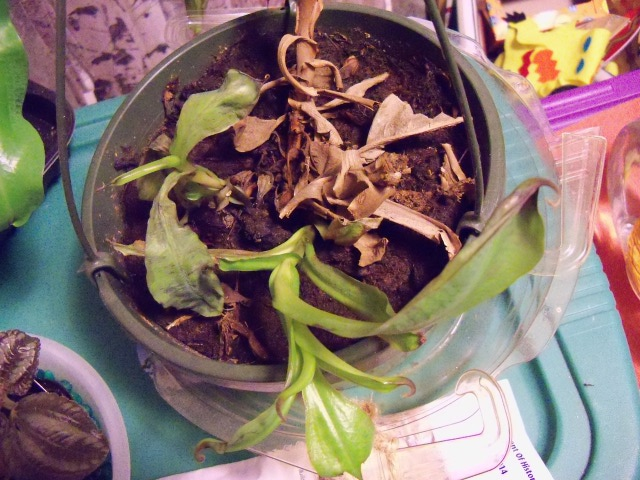Question
 Nepenthes Problem
Nepenthes Problem
Good morning,
I am growing a Nepenthes plant and it has developed this black coloration on the tips of its new growth and the edges of its leaves. I grow it in an average room, with Eastern and Southern natural light in Northern Mideast. The temperature is usually around 68 and the humidity varies with the season (more in summer, less in winter). It gets watered on a regular basis with distilled water. I've had it for a little over a year and have never repotted it; it grows in the substrate it came in, which is not regular potting soil. It hasn't had any pitchers since I got it, however.
Thank you for your help,
Penguin
AnswerBased on your photo, there are two issues going on. The first is the soil. It looks like 100% peat moss. Nepenthes requires well drained soil for proper root aeration. Without it, root health will decline, which is already happening based on the new growth. Peat moss alone compacts over time and doesn't aerate the roots properly. Other ingredients, such as perlite, bark, and pumice, are necessary to allow good drainage and aeration.
The other factor is lighting. You mentioned growing it in a Southeast window. This may be appropriate, but the plant should get several hours of direct sunlight for optimal health. Based on the leaves and pot size, it looks like you have Nepenthes Miranda, which is a very common hybrid in cultivation. This hybrid requires very strong lighting, almost full sun conditions. The leaves should have some red hues in them. Your current leaves look rather pale. Without adequate lighting, Nepenthes won't be able to produce sufficient energy and will weaken over time. Lack of proper lighting is also the main reason why Nepenthes fail to produce pitchers.
With the two issues combined, your plant may or may not recover, depending on how much time and effort you're willing to put into the plant. First thing is to repot the plant into fresh soil. After that, you need to make sure the plant gets several hours of direct sunlight. The time it will take for the plant to recover fully depends on how severely weakened the plant currently is. It could take up to a year before the plant looks full and lush again. However, the plant may also decline in health regardless of the effort. You should know within a month after making these changes whether or not the plant will make it.
For information about appropriate soil mixes, read our care guide on our main website.
http://www.growcarnivorousplants.com/careguides
Good growing!
Jacob Farin






